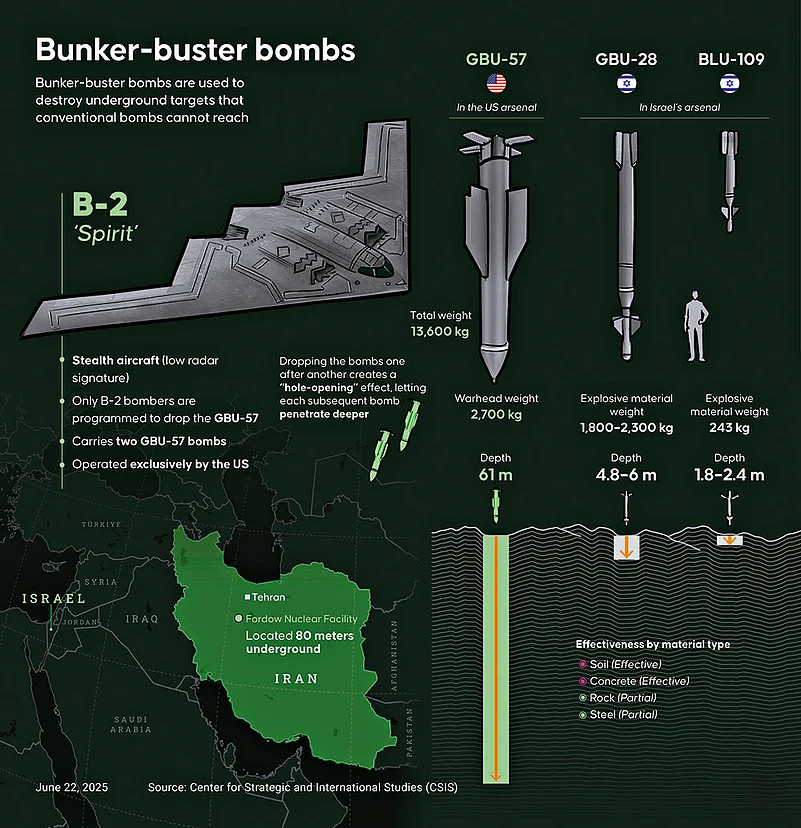On the night of June 20/21, 2025, the United States launched Operation Midnight Hammer against Iran, the largest B-2 operational strike in its history, in order to destroy or severely degrade Iran’s nuclear programme. This was a set of precision attacks against three nuclear facilities: Fordow, Natanz and Esfahan. The strike package comprised of bombers launched from the continental United States. In order to maintain surprise, part of the package proceeded westward into the Pacific as decoy. The main strike package comprising of seven B-2 Spirit bombers, each with two crew members, proceeded to the east with minimal communications, covering the 18-hour flight into the target area, with multiple in-flight refuelling.
Once over land, the B-2s linked up with escort and support aircraft in a complex synchronisation manoeuvre–with fourth and fifth generation aircraft sweeping the area in front of the strike package for Iranian fighters and surface-to-air missiles. Just prior to the strike package entering Iran, a US submarine launched over two dozen Tomahawk land attack cruise missiles against key surface infrastructure targets at Esfahan. At 2.10 am Iran time, the lead B-2 bomber dropped the first two GBU-57 Massive Ordinance Penetrator (MOP) weapons at Fordow. A total of 14 MOPs were dropped against Fordow and Natanz. Tomahawk missiles were employed to strike at Esfahan. This was the first ever operational use of the 30,000-pound GBU–57 Massive Ordinance Penetrator.
While the White House initially claimed, “obliteration” of the nuclear facilities, the Chairman, Joint Chiefs of Staff was more realistic to state that “final battle damage will take some time, but initial battle damage assessments indicate that all three sites sustained extremely severe damage and destruction.” The satellite imagery must be woven together with human intelligence (HUMINT) and communications intelligence (COMINT) to build a comprehensive and credible intelligence picture. This takes time.

The US attack on Iran came in the wake of Operation Rising Lion, launched by Israel against Iran. Starting in the early hours of June 13, 2025, waves of Israeli precision strikes attacked Iran’s uranium enrichment and weaponisation facilities, advanced missile manufacturing sites and launch facilities operated by the Islamic Revolutionary Guard Corps, top military commanders and scientists. Iran retaliated with large-scale drones and ballistic missiles, some of which succeeded in penetrating Israel’s air defence system.
In Op Rising Lion, Israel integrated swarms of drones with fighter aircrafts including stealth, in two distinct but complementary actions. First, swarms of small explosive- laden drones pre-positioned inside Iran by Israeli commandos months earlier targeted Iran’s air-defense radars, early warning and communications nodes. The drone attacks were immediately followed by over 200 Israeli fighter aircraft including F-35 carrying standoff munitions, conducting precision strikes against more than 100 nuclear and military targets across Iran. The drone attacks saturated Iran’s early-warning networks. With communication networks disrupted and senior commanders killed or forced into hardened shelters, Iran’s decision-making ability was paralysed just as the fighter aircrafts hit their targets with precision strikes. The strike packages of both Israel, and later the US, had a free run with no opposition.
After the US attack on Iran, since June 24, 2025 a ceasefire, albeit fragile, holds between Israel and Iran. The truce has been brokered by the peace-maker US President Trump.
For the moment, it is all victors—no vanquished! The US claims victory for having degraded Iran’s nuclear programme, pushing it back by years, if not decades. Iranian President Masoud Pezeshkian said his country had successfully ended the war in a “great victory”, and was ready to resolve differences with the US. Iran’s military command warned Israel and the US to learn from the “crushing blows” it delivered during the conflict; for the first time, Israeli air defences were penetrated by large numbers of Iranian missiles. Israeli Prime Minister Benjamin Netanyahu declared, “We have removed two immediate existential threats to Israel: the threat of nuclear annihilation and the threat of annihilation by 20,000 ballistic missiles.”
The political and commercial landscape surrounding these operations have veered towards early conflict termination. The US experience of Iraq and Afghanistan which started with resounding initial victories that ultimately turned into losses, is shaping its latest strategy of accomplishing a “visible notion of victory” and making a “swift exit”. Operation Midnight Hammer has steered clear of getting embroiled in regime change or its messy aftermath, which in effect would have implied “boots on the ground” and a long, drawn-out war. Both Israel and Iran, after some initial retaliation and violation of the ceasefire, have come around to accepting the truce.
Human casualties and economic costs of long wars were always questioned. In this new age of information and misinformation, long wars are doomed to fail either way. Israel’s own experience in the ongoing Gaza conflict since October 7, 2023, and the ongoing Russia-Ukraine War since February 24, 2022, reveal the futility of the use of force beyond a point. In today’s day and age, the information explosion has expanded the battlespace far beyond the battlefield. The media world has moved from an era of “few producers and many consumers” into an era where almost everyone is a producer, and everyone is a consumer. Conflicts are no longer limited to warring states; interested parties direct and/or indirect, exist on a global scale. The Ukraine War has encouraged direct participation of commercial entities in intelligence, surveillance, reconnaissance and data management. Under such circumstances, both traditional and social media complemented by artificial intelligence are being used freely to spin narratives to suit not only political aims but commercial interests as well. There are no ethics or equivalents of international humanitarian laws applicable to the information war.
With the proliferation of autonomous systems, the time and space dimensions in war have been disrupted. Quite like the June 13 swarm of drones’ action in Op Rising Lion, on June 1, 2025, Ukraine had undertaken Op Spider Web, a drone offensive targeting Russian military airfields. In this operation small, low-cost FPV (Full Person View) drones were covertly transported into Russian territory. Ukraine’s drones struck airfields across five Russian regions, damaging or destroying numerous Russian military aircraft, including strategic bombers and early-warning radar.
Both in Op Spider Web and Op Rising Lion, autonomous systems (drone swarms) integrated with AI-enabled intelligence, surveillance and reconnaissance have demonstrated the potential to overwhelm air defence systems and command and control faster than any strike package and at a much higher scale. Innovative prepositioning of the autonomous systems through special operations has disrupted traditional notions of depth in defences, setting the stage for a more or less free run for the main strike. The ability of low-cost drones to cause substantial dislocation and disruption of early warning, communications and air defence systems is going to force the defender to add multiple layers to defense of military assets as well as critical infrastructure.
Is this then the beginning of a shift away from boots on the ground? For India, with unsettled borders with China and Pakistan (in Jammu & Kashmir and in Ladakh), the military nexus between the two countries, and cross-border counter-terrorist operations, capabilities for the foreseeable future require human-machine integration that enhances combat effectiveness, improves situational awareness and overcomes battlefield challenges. Tri-service structures like the Special Operations Division, Defence Space Agency and Defence Cyber Agency need to be strengthened on a mission mode with new-age technologies. Pre-empting any possibility of pre-placement of autonomous systems targeted at our military or critical infrastructure will require a very high order of synchronisation of intelligence activity. Ultimately, we have to ‘Win India’s Wars with Indian Solutions’.
(Views expressed are personal)
MORE FROM THIS ISSUE
Lt Gen Dr Subrata Saha (Retd) is Executive Chairman of the Manekshaw Centre Of Excellence For National Security Studies And Research
This article is part of 카지노 Magazine's July 11, 2025 issue, Making Bombing Great Again. It appeared in print as 'The Way We War'.






















